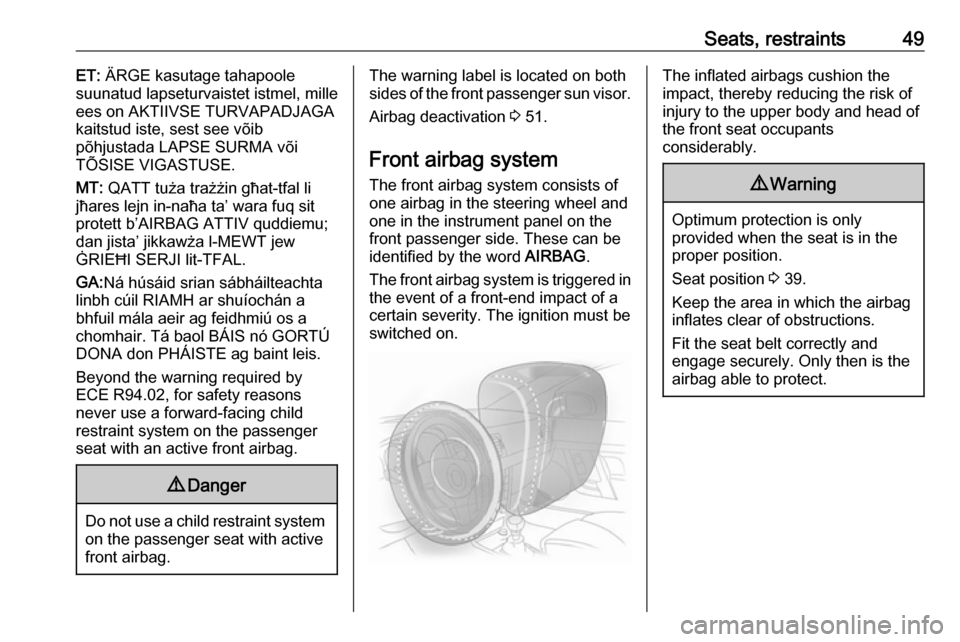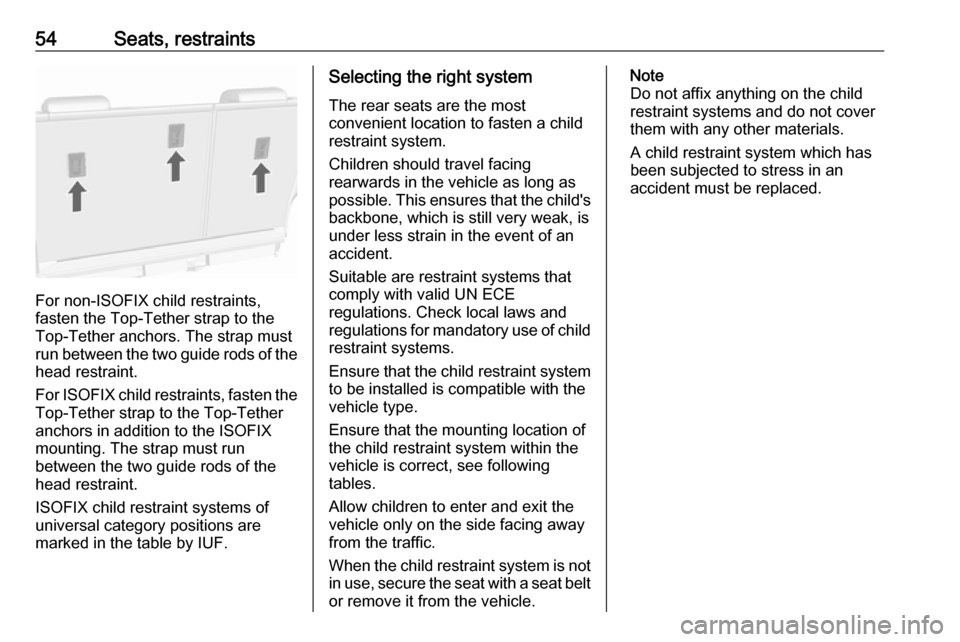OPEL MOKKA X 2018 Infotainment system
Manufacturer: OPEL, Model Year: 2018, Model line: MOKKA X, Model: OPEL MOKKA X 2018Pages: 251, PDF Size: 6.61 MB
Page 51 of 251

Seats, restraints49ET: ÄRGE kasutage tahapoole
suunatud lapseturvaistet istmel, mille
ees on AKTIIVSE TURVAPADJAGA
kaitstud iste, sest see võib
põhjustada LAPSE SURMA või
TÕSISE VIGASTUSE.
MT: QATT tuża trażżin għat-tfal li
jħares lejn in-naħa ta’ wara fuq sit
protett b’AIRBAG ATTIV quddiemu;
dan jista’ jikkawża l-MEWT jew
ĠRIEĦI SERJI lit-TFAL.
GA: Ná húsáid srian sábháilteachta
linbh cúil RIAMH ar shuíochán a
bhfuil mála aeir ag feidhmiú os a
chomhair. Tá baol BÁIS nó GORTÚ
DONA don PHÁISTE ag baint leis.
Beyond the warning required by
ECE R94.02, for safety reasons
never use a forward-facing child
restraint system on the passenger
seat with an active front airbag.9 Danger
Do not use a child restraint system
on the passenger seat with active
front airbag.
The warning label is located on both
sides of the front passenger sun visor.
Airbag deactivation 3 51.
Front airbag system The front airbag system consists of
one airbag in the steering wheel and
one in the instrument panel on the
front passenger side. These can be
identified by the word AIRBAG.
The front airbag system is triggered in
the event of a front-end impact of a
certain severity. The ignition must be
switched on.The inflated airbags cushion the
impact, thereby reducing the risk of
injury to the upper body and head of
the front seat occupants
considerably.9 Warning
Optimum protection is only
provided when the seat is in the
proper position.
Seat position 3 39.
Keep the area in which the airbag
inflates clear of obstructions.
Fit the seat belt correctly and
engage securely. Only then is the
airbag able to protect.
Page 52 of 251

50Seats, restraintsSide airbag system
The side airbag system consists of an
airbag in each front seat backrest.
This can be identified by the word
AIRBAG .
The side airbag system is triggered in the event of a side impact of a certain
severity. The ignition must be
switched on.
The inflated airbags cushion the
impact, thereby reducing the risk of
injury to the upper body and pelvis in
the event of a side-on collision
considerably.
9 Warning
Keep the area in which the airbag
inflates clear of obstructions.
Note
Only use protective seat covers that
have been approved for the vehicle.Be careful not to cover the airbags.
Curtain airbag system
The curtain airbag system consists of an airbag in the roof frame on each
side. This can be identified by the
word AIRBAG on the roof pillars.
The curtain airbag system is triggered
in the event of a side-on impact of a
certain severity. The ignition must be
switched on.
Page 53 of 251

Seats, restraints51
The inflated airbags cushion the
impact, thereby reducing the risk of
injury to the head in the event of a
side-on impact considerably.
9 Warning
Keep the area in which the airbag
inflates clear of obstructions.
The hooks in the roof frame are
only suitable for hanging up light
articles of clothing, without coat
hangers. Do not keep any items in these clothes.
Airbag deactivation
The front passenger airbag system
must be deactivated if a child restraint
system is to be fitted on this seat. The side airbag and curtain airbag
systems, the belt pretensioners and
all driver airbag systems will remain
active.
The front passenger airbag system
can be deactivated via a key-
operated switch on the passenger side of the instrument panel.
Use the ignition key to choose the
position:c:front passenger airbags are
deactivated and will not inflate
in the event of a collision.
Control indicator c
illuminates continuously in the
centre console. A child
restraint system can be
installed in accordance with
the chart Child restraint
installation locations 3 55.
No adult person is allowed to
occupy the front passenger
seat.d:front passenger airbags are
active. A child restraint system
must not be installed.9 Danger
Risk of fatal injury for a child using
a child restraint system on a seat
with activated front passenger
airbag.
Risk of fatal injury for an adult
person on a seat with deactivated
front passenger airbag.
Page 54 of 251

52Seats, restraints
As long as the control indicator c is
not illuminated, the front passenger
airbag system will inflate in the event
of a collision.
Change status only when the vehicle is stopped with the ignition off.
Status remains until the next change.
Control indicator for airbag
deactivation 3 94.
Child restraints
Child restraint systems
We recommend the Opel child
restraint system which is tailored
specifically to the vehicle.
When a child restraint system is being
used, pay attention to the following
usage and installation instructions
and also those supplied with the child restraint system.
Always comply with local or national
regulations. In some countries, the
use of child restraint systems is
forbidden on certain seats.9 Warning
When using a child restraint
system on the front passenger
seat, the airbag systems for the
front passenger seat must be
deactivated; if not, the triggering of the airbags poses a risk of fatal
injury to the child.
This is especially the case if rear-
facing child restraint systems are
used on the front passenger seat.
Airbag deactivation 3 51.
Airbag label 3 46.
Child restraint systems can be
fastened with:
● ISOFIX brackets
● Top-tether anchor
ISOFIX child restraint systems
For the installation of ISOFIX child
restraint systems, two variants are
available:
● Installation of ISOFIX child restraint systems without
permanent guide
● Installation of ISOFIX child restraint systems with permanentguide
Page 55 of 251

Seats, restraints53Installation of ISOFIX child restraint
systems without permanent guide
Fasten vehicle-approved ISOFIX
child restraint systems to the ISOFIX
mounting brackets. Specific vehicle
ISOFIX child restraint system
positions are marked in the table by
IL.
ISOFIX mounting brackets are
indicated by a label on the backrest.
Installation of ISOFIX child restraint
systems with permanent guide
The vehicle might be equipped with
guides in front of the mounting
brackets to support the installation of the child restraint system.
The covers of the guides will swivel
backwards automatically when
attaching the child restraint system.
Top-tether anchors Depending on country specific
equipment, the vehicle might have
two or three fastening eyes.
Top-Tether anchors are marked with
the symbol : for a child restraint.
Page 56 of 251

54Seats, restraints
For non-ISOFIX child restraints,
fasten the Top-Tether strap to the
Top-Tether anchors. The strap must
run between the two guide rods of the
head restraint.
For ISOFIX child restraints, fasten the
Top-Tether strap to the Top-Tether
anchors in addition to the ISOFIX
mounting. The strap must run
between the two guide rods of the
head restraint.
ISOFIX child restraint systems of
universal category positions are
marked in the table by IUF.
Selecting the right system
The rear seats are the most
convenient location to fasten a child
restraint system.
Children should travel facing
rearwards in the vehicle as long as
possible. This ensures that the child's backbone, which is still very weak, is
under less strain in the event of an
accident.
Suitable are restraint systems that
comply with valid UN ECE
regulations. Check local laws and
regulations for mandatory use of child restraint systems.
Ensure that the child restraint system
to be installed is compatible with the
vehicle type.
Ensure that the mounting location of
the child restraint system within the
vehicle is correct, see following
tables.
Allow children to enter and exit the
vehicle only on the side facing away
from the traffic.
When the child restraint system is not in use, secure the seat with a seat beltor remove it from the vehicle.Note
Do not affix anything on the child
restraint systems and do not cover
them with any other materials.
A child restraint system which has
been subjected to stress in an
accident must be replaced.
Page 57 of 251

Seats, restraints55Child restraint installation locations
Permissible options for fitting a child restraint system
Weight class
On front passenger seat
On rear outboard seatsOn rear centre seat
activated airbagdeactivated airbagGroup 0: up to 10 kgXU 1U 2U2Group 0+: up to 13 kgXU1U 2U2Group I: 9 to 18 kgXU1U2U2Group II: 15 to 25 kgXXU2U2Group III: 22 to 36 kgXXU 2U21:if the child restraint system is being secured using a three-point seat belt, move seat height adjustment to uppermost
position and ensure that vehicle seat belt runs forwards from the upper anchorage point. Adjust seat backrest
inclination as far as necessary to a vertical position to ensure that the belt is tight on the buckle side.2:move the head restraint to uppermost position. If it interferes with the proper installation of the child restraint system, remove the head restraint 3 38.U:universal suitability in conjunction with three-point seat belt.X:no child restraint system permitted in this weight class.
Page 58 of 251

56Seats, restraintsPermissible options for fitting an ISOFIX child restraint systemWeight classSize classFixtureOn front passenger seatOn rear outboard seatsOn rear centre seatGroup 0: up to 10 kgEISO/R1XIL1XGroup 0+: up to 13 kgEISO/R1XIL1XDISO/R2XIL1XCISO/R3XIL1XGroup I: 9 to 18 kgDISO/R2XIL 1XCISO/R3XIL1XBISO/F2XIL, IUFXB1ISO/F2XXIL, IUFXAISO/F3XIL, IUFXGroup II: 15 to 25 kgXILXGroup III: 22 to 36 kgXILX1:move front passenger seat to the foremost position or adjust front seat backrest inclination as far as necessary to
a vertical position to ensure that there is no interference between child restraint system and front seat backrest.IL:suitable for particular ISOFIX restraint systems of the "specific-vehicle", "restricted" or "semi-universal" categories.
The ISOFIX restraint system must be approved for the specific vehicle type.IUF:suitable for ISOFIX forward-facing child restraint systems of universal category approved for use in this weight class.X:no ISOFIX child restraint system approved in this weight class.
Page 59 of 251

Seats, restraints57ISOFIX size class and seat deviceA – ISO/F3:forward-facing child restraint system for children of maximum size in the weight class 9 to 18 kgB – ISO/F2:forward-facing child restraint system for smaller children in the weight class 9 to 18 kgB1 – ISO/F2X:forward-facing child restraint system for smaller children in the weight class 9 to 18 kgC – ISO/R3:rear-facing child restraint system for children of maximum size in the weight class up to 18 kgD – ISO/R2:rear-facing child restraint system for smaller children in the weight class up to 18 kgE – ISO/R1:rear-facing child restraint system for young children in the weight class up to 13 kg
Page 60 of 251

58Seats, restraintsISOFIX child restraintsystems
Installation of ISOFIX child
restraint systems without
permanent guide
Fasten vehicle-approved ISOFIX
child restraint systems to the ISOFIX
mounting brackets. Specific vehicle
ISOFIX child restraint system
positions are marked in the table by
IL.
ISOFIX mounting brackets are
indicated by a label on the backrest.
Installation of ISOFIX child
restraint systems with permanent
guide
The vehicle might be equipped with
guides in front of the mounting
brackets to support the installation of the child restraint system.